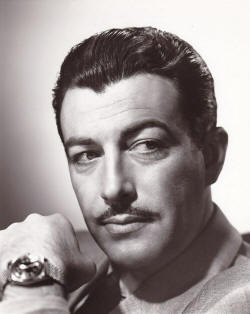

Queer Places:
707 N Arden Dr, Beverly Hills, CA 90210
Forest Lawn Memorial Park
Glendale, Los Angeles County, California, USA
 Robert Taylor (born Spangler Arlington Brugh; August 5, 1911 – June 8, 1969) was an American film and television actor and singer who was one of the most popular leading men of his time.
Marriage between gay men and lesbian women were common in Hollywood. Such
marriages included those between MGM’s chief art director
Cedric Gibbons and
Dolores del Rio, or Edmund Lowe
and Lilyan Tashman, or
Rudolph Valentino and
Jean Acker (the lover of
Grace Darmond and, at another
time, of Alla Nazimova), or
Janet Gaynor (later the lover
of Mary Martin) and costume
designer Adrian, or
Barbara Stanwyck and
Robert Taylor.
Robert Taylor (born Spangler Arlington Brugh; August 5, 1911 – June 8, 1969) was an American film and television actor and singer who was one of the most popular leading men of his time.
Marriage between gay men and lesbian women were common in Hollywood. Such
marriages included those between MGM’s chief art director
Cedric Gibbons and
Dolores del Rio, or Edmund Lowe
and Lilyan Tashman, or
Rudolph Valentino and
Jean Acker (the lover of
Grace Darmond and, at another
time, of Alla Nazimova), or
Janet Gaynor (later the lover
of Mary Martin) and costume
designer Adrian, or
Barbara Stanwyck and
Robert Taylor.
Born Spangler Arlington Brugh on August 5, 1911, in Filley, Nebraska, Taylor was the only child of Ruth Adaline (née Stanhope) and Spangler Andrew Brugh, a farmer turned doctor.[1][2] During his early life, the family moved several times, living in Muskogee, Oklahoma; Kirksville, Missouri; and Fremont, Nebraska. By September 1917, the Brughs had moved to Beatrice, Nebraska, where they remained for 16 years.[3] As a teenager, Taylor was a track and field star and played the cello in his high school orchestra. Upon graduation, he enrolled at Doane College in Crete, Nebraska.[4] While at Doane, he took cello lessons from Professor Herbert E. Gray, whom he admired and idolized. After Professor Gray announced he was accepting a new position at Pomona College in Claremont, California, Taylor moved to California and enrolled at Pomona.[5] He joined the campus theater group and was eventually spotted by an MGM talent scout in 1932 after a production of Journey's End.
Taylor began his career in films in 1934 when he signed with Metro-Goldwyn-Mayer. He made his film debut in the 1934 comedy Handy Andy, starring Will Rogers (on loan to Fox Studios).
In 1935, Irene Dunne requested him for her leading man in Magnificent Obsession. This was followed by Camille with Greta Garbo.[8]
Considering the work of classic Hollywood's gay directors and gay producers, a small but vital subset of the studio system, suggests "queer cinema" might not be such a modern postulate. Occasionally, a convergence of director, producer, writer, and star came together, such as happened with Camille (1937). The gay writer DeWitt Bodeen said that Camille "represents a meeting of talents that were perfect for its interpretation." In fact, wags like to call the picture a rare "all-gay" studio production, and in some ways it comes close: producer David Lewis, director George Cukor, screenwriter Zoe Akins. Greta Garbo, too, and Mercedes de Acosta had a hand in the early draft of the script before Akins took over. Robert Taylor, who played a stunningly beautiful Armand, was rumored to be having an affair with the film's set decorator, Jack Moore. There was also Adrian on costumes and Sydney Guilaroff doing hair. Rex O'Malley infused his Gaston with a natural feyness, a quality perhaps intended by Cukor and Akins, and another gay actor, Rex Evans, played several bit parts. ("Who is that big man and what part is he playing?" Garbo asked Cukor. "That man is Rex Evans," the director replied, "and he's playing the part of a friend who needs a job.") Cukor also manuevered the hiring of another friend, and another gay man, as the picture's true art director, supplanting the ubiquitous Cedric Gibbons, whose contract nonetheless decreed screen credit. This was Oliver Messel, esteemed scenic and costume designer from the London stage, whose outsider status evoked suspicion in the competitive world of the Hollywood studios. It wasn't Messel's first encounter with the studio bureaucracy; in 1935, during the filming of Romeo and Juliet, Cukor had caused a near war by insisting Messel design the costumes instead of Adrian, whom Cukor, according to several friends, viewed as pompous and pretentious. Cukor, as discreet as he was, never tried to obfuscate either his Jewishness or his gayness in the way Adrian did. "I get annoyed with statements that call George "closeted",", said his longtime friend and Los Angeles Times film critic Kevin Thomas. "George was never closeted. He never pretended to be anything he wasn't. He lived according to the rules of his time, that's all."
Robert Taylor's popularity increased during the late 1930s and 1940s with appearances in A Yank at Oxford (1938), Waterloo Bridge (1940), and Bataan (1943). During World War II, he served in the United States Naval Air Forces, where he worked as a flight instructor and appeared in instructional films. From 1959 to 1962, he starred in the series The Detectives Starring Robert Taylor. In 1966, he took over hosting duties from his friend Ronald Reagan on the series Death Valley Days.
Taylor was married to actress Barbara Stanwyck from 1939 to 1951. He married actress Ursula Thiess in 1954, and they had two children.
A chain smoker, Taylor died of lung cancer at the age of 57. Taylor's funeral was held at Forest Lawn Memorial Park Cemetery, in Glendale, California. Long-time friend Ronald Reagan (who was then the governor of California) eulogized Taylor. Among the mourners were Robert Stack, Van Heflin, Eva Marie Saint, Walter Pidgeon, Keenan Wynn, Mickey Rooney, George Murphy, Audrey Totter and Taylor's ex-wife Barbara Stanwyck.[42]
My published books: